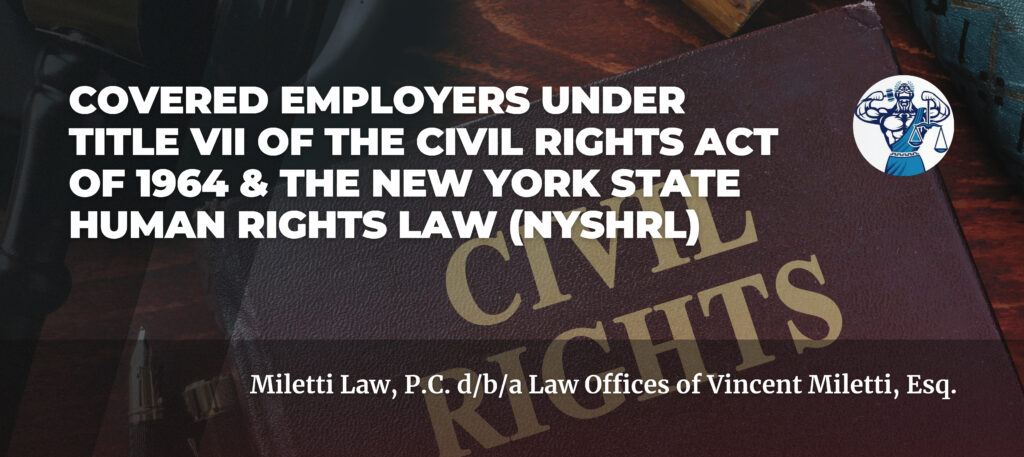Here at Miletti Law®, it’s our commitment to continue publishing blogs and making videos that aim to keep you, our unusually motivated® readers, #InTheKnow about diverse legal and non-legal issues that affect you or your businesses. Usually, the content is featured as videos that are posted on our YouTube Channel at https://www.youtube.com/channel/UCtvUryqkkMAJLwrLu2BBt6w and blogs that are published on our website WWW.MILETTILAW.COM. We highly encourage you to subscribe to the channel and sign up for the Newsletter on the website to receive updates firsthand.
Being a firm of our word is an integral part of our culture and, therefore, here we are to keep the promise we made in the previous part of the series on the New York City (NYC) Labor Law. In Part V, we hammered on another essential area of the NYC Labor Law, particularly the “New York City Earned Safe and Sick Time Act (NYC ESSTA)” statute.
In pursuit of our goal to keep you enlightened and educated, we endeavor to move forward the discussion on the NYC ESSTA in this blog and Part VI of the series. However, we’d like to shift our focus and educate you on where the NYC ESSTA stands in the face of the COVID-19 pandemic. Notably, special to this blog, we’ve provided you, as an employer, with key tips on how to remain compliant with this law.
The NYC ESSTA & Coronavirus Disease 2019 (COVID-19)
In Part V of the series, we mentioned that under the NYC ESSTA, employers are obligated to provide full-time & part-time employees, employees who are family members but not owners, transitional jobs program employees, and employees who live outside of New York City with sick leave. Unfortunately, although employees can use the NYC ESSTA sick leave to seek medical care or diagnosis, treat a health condition, an injury, physical, and/or mental illness, or to look for preventive medical care, sick leave attributable to COVID-19 has not been specifically addressed under the NYC ESSTA. However, it has been clarified by the City Commission that employees can use the NYC ESSTA leave under the following provisions:
- If an employee tests positive for COVID-19 or the flu;
- If an employee falls ill or shows the symptoms of COVID-19;
- If the employee is quarantined or self-isolating for the purposes of preventing the spread of COVID-19; or
- If the employee is providing care for a family member under a precautionary or mandatory quarantine or self-isolating order.
NYC ESSTA Documentation and Notice Requirements
Employers are permitted to seek notification and documentation from all employees who want to use the NYC ESSTA. On the one hand, for foreseeable uses of sick leave, an employer can require up to a week’s notice. On the other hand, when it comes to unforeseeable uses of sick leave, it’s within the employer’s discretion to require reasonable notice. However, if an employee takes three consecutive workdays as safe or sick leave, it’s within the employer’s discretion to require documentation.
When it comes to safe leave, examples of documentation that an employer can require include police or court records, notarized letter from an employee, or a document signed by an attorney, a social services provider, or a member of clergy. Further, when it comes to sick leave, an employer can seek a document signed by a licensed healthcare provider. However, although they can generally seek verification that time was utilized for the safe or sick leave purposes indicated, employers cannot require such documentation to state the specific reason why the employee sought leave.
NOTE: The NYC ESSTA obligates employers to provide each employee with a written notice outlining their rights under the law. Importantly, they must also take note of the total amount of the NYC ESSTA leave accrued and utilized during a period of pay, as well as an employee’s balance of accrued leave on a paystubs, statements, or other documentation employees are provided with when receiving their pay.
How to Remain Compliant with the NYC ESSTA
In our past videos and blogs, we’ve always stressed on the significance of employers remaining compliant with labor laws and other related statutes. In order to keep you at the top of the game, here are four vital steps you need, as an employer to remain compliant with the NYC ESSTA:
- Review the NYC ESSTA amendments made on September 28, 2020 to ascertain that the provisions align with your written sick and safe leave policies;
- Ensure that all employees, irrespective of position in the company or relationship with you, all are provided with a copy of the required written notice of rights and there are proper posting in conspicuous areas;
- Make sure that Human Resource (HR) professionals and managers are trained and conversant with what the law says, especially after the September 28, 2020 amendments, about how sick and safe leave should be administered;
- Emphasize the importance of indicating the amount of leave used and accrued during the period of pay, as well as the balance of accrued time on the paystubs, statements, or any other documentation employees are provided with each period of pay.
Stay tuned for Part VII of this series and always be #UnusuallyMotivated. In the interim, if there are any questions or comments, please let us know via the Contact Us page!
Always rising above the bar,
Isaac T.,
Legal Writer & Author.
 Professional Legal & Business Services And Representation - English & Espanol!
Professional Legal & Business Services And Representation - English & Espanol!

 314-648-2586
314-648-2586 CALL US NOW
CALL US NOW








